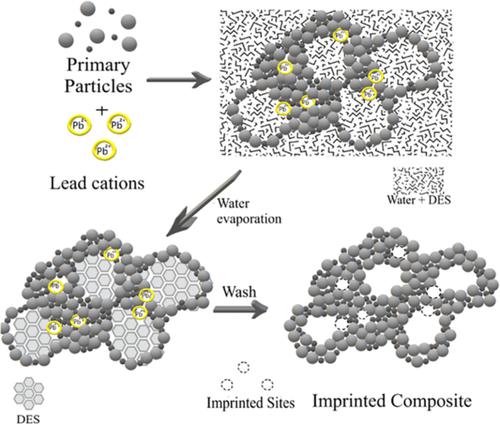当前位置:
X-MOL 学术
›
J. Appl. Polym. Sci.
›
论文详情
Our official English website, www.x-mol.net, welcomes your
feedback! (Note: you will need to create a separate account there.)
Cation‐bioimprinted mesoporous polysaccharide/sol–gel composites prepared in media containing choline chloride‐based deep eutectic solvents
Journal of Applied Polymer Science ( IF 2.7 ) Pub Date : 2019-12-17 , DOI: 10.1002/app.48842 V. R. A. Ferreira 1 , M. A. Azenha 1 , C. M. Pereira 1 , A. F. Silva 1
Journal of Applied Polymer Science ( IF 2.7 ) Pub Date : 2019-12-17 , DOI: 10.1002/app.48842 V. R. A. Ferreira 1 , M. A. Azenha 1 , C. M. Pereira 1 , A. F. Silva 1
Affiliation

|
A study on the Pb(II) imprinting performed within mesoporous sulphated biopolymer/siloxane composites, prepared in media containing deep eutectic solvent (DES), is described. In general, the process of imprinting resulted in greatly increased surface areas relatively to the corresponding nonimprinted composites [up to fivefold (from 76 m2 g−1 to 360 m2 g−1) for fucoidan (Fuc) and up to twofold (from 208 m2 g−1 to 351 m2 g−1) for chondroitin sulfate (CS) composites], the diminishing of mean pore size (from 3.3–4.6 nm to 2.9–3.4), and higher biopolymer contents (from mass fractions of 0.42–0.52 to 0.46–0.68). The sorption features depended a great deal on the biopolymer/DES combination. The best CS composite, allowed for 12% capacity and 20% binding strength, as well as Pb(II)/Cd(II) selectivity enhancements. The largest of the capacities was obtained with the imprinted Fuc/DES‐E composite, 86 mg g−1, a 10% increase. Concerning the selectivity [Pb(II) versus Cd(II)], there was a significant increase for the CS composites (from 1.0–1.1 (αqmax)/1.1–1.2 (αK) to 1.3–1.4 (αqmax)/1.3–1.6 (αK)]. In particular, the DES‐E CIC presented high selectivity factors (αqmax 3.0/αK 3.2) in line with those of the microporous version (αqmax 2.0/αK 3.3) but showing a significant increase in terms of the αqmax selectivity. © 2019 Wiley Periodicals, Inc. J. Appl. Polym. Sci. 2020, 137, 48842.
中文翻译:

在含有氯化胆碱的低共熔溶剂的介质中制备的阳离子生物印迹中孔多糖/溶胶-凝胶复合材料
描述了在含深共熔溶剂(DES)的介质中制备的中孔硫酸盐生物聚合物/硅氧烷复合材料中的Pb(II)印迹的研究。通常,压印过程相对于相应的非压印复合材料而言表面积大大增加[对于岩藻依聚糖(Fuc)而言,其表面积增加了五倍(从76 m 2 g -1到360 m 2 g -1),而在两倍于胶体中,则增加了两倍。 208 m 2 g -1至351 m 2 g -1)(对于硫酸软骨素(CS)复合材料),平均孔径(从3.3-4.6 nm减小到2.9-3.4)和更高的生物聚合物含量(从质量分数0.42-0.52到0.46-0.68)。吸附特性在很大程度上取决于生物聚合物/ DES的组合。最好的CS复合材料,允许12%的容量和20%的结合强度,以及Pb(II)/ Cd(II)选择性增强。压印的Fuc / DES‐E复合材料获得最大的容量,为86 mg g -1,增加了10%。关于选择性[铅(II)与镉(II)],有对于CS复合材料一个显著增加(从1.0-1.1(α的qmax)/1.1-1.2(α ķ)至1.3-1.4(α Q最大)/ 1.3-1.6(α ķ)]。特别是,DES-E CIC呈现高选择性因子(α Q最大3.0 /α ķ 3.2)在与这些的微孔版本线(α Q最大2.0 /α ķ 3.3),但示出了在α换算的显著增加的qmax选择性。分级为4 +©2019 Wiley Periodicals,Inc.J.Appl。Polym。科学 2020,137,48842。
更新日期:2020-03-27
中文翻译:

在含有氯化胆碱的低共熔溶剂的介质中制备的阳离子生物印迹中孔多糖/溶胶-凝胶复合材料
描述了在含深共熔溶剂(DES)的介质中制备的中孔硫酸盐生物聚合物/硅氧烷复合材料中的Pb(II)印迹的研究。通常,压印过程相对于相应的非压印复合材料而言表面积大大增加[对于岩藻依聚糖(Fuc)而言,其表面积增加了五倍(从76 m 2 g -1到360 m 2 g -1),而在两倍于胶体中,则增加了两倍。 208 m 2 g -1至351 m 2 g -1)(对于硫酸软骨素(CS)复合材料),平均孔径(从3.3-4.6 nm减小到2.9-3.4)和更高的生物聚合物含量(从质量分数0.42-0.52到0.46-0.68)。吸附特性在很大程度上取决于生物聚合物/ DES的组合。最好的CS复合材料,允许12%的容量和20%的结合强度,以及Pb(II)/ Cd(II)选择性增强。压印的Fuc / DES‐E复合材料获得最大的容量,为86 mg g -1,增加了10%。关于选择性[铅(II)与镉(II)],有对于CS复合材料一个显著增加(从1.0-1.1(α的qmax)/1.1-1.2(α ķ)至1.3-1.4(α Q最大)/ 1.3-1.6(α ķ)]。特别是,DES-E CIC呈现高选择性因子(α Q最大3.0 /α ķ 3.2)在与这些的微孔版本线(α Q最大2.0 /α ķ 3.3),但示出了在α换算的显著增加的qmax选择性。分级为4 +©2019 Wiley Periodicals,Inc.J.Appl。Polym。科学 2020,137,48842。











































 京公网安备 11010802027423号
京公网安备 11010802027423号